The Snapdragon 845 Performance Preview: Setting the Stage for Flagship Android 2018
by Ryan Smith & Andrei Frumusanu on February 12, 2018 12:30 AM EST- Posted in
- Mobile
- Snapdragon
- Qualcomm
- Smartphones
- SoCs
- Snapdragon 845
System Performance
To see how the new CPUs and memory subsystem translate into more real system performance, we move onto more representative tests such as PCMark. PCMark’s performance is affected by several factors: not only does raw performance of the hardware count but also we need to consider the individual system’s software stack. We’ve seen large differences between Android OS major versions where the improvements of the Android Runtime can be directly visible in subtests such as the Writing test. Also a SoC’s DVFS schemes and schedulers can have huge impacts on “performance-latency”, meaning how fast the CPUs can ramp up a workload. This directly translates in a lot more performance in several of PCMark’s subtests as in the default settings none of the tests actually represent the pure performance of the CPU if it were locked at maximum frequency on the performance cores. The results of the tests are also overall a good representation of “snappiness” of a device.
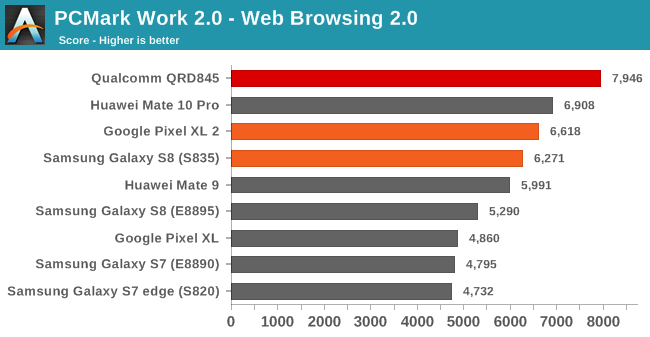
In the web browsing test the Snapdragon 845 QRD manages to outpace the Pixel 2 XL by 20%. Here we’re also looking at performance across devices with different OS versions. The Google devices are running Android 8.1 while the Samsung devices were tested with Android 7.0. The Mate 10 Pro runs Android 8.0 while the Mate 9 still had 7.0. The Qualcomm QRD we tested ran Android 8.0.
Again the performance increase over Snapdragon 835 devices isn’t all that great. DynamiQ allows for far more efficient thread transitions between the CPU cores and subsequently I expected Qualcomm to take advantage of this through more aggressive scheduling resulting in more than just a 20% increase. The difference between the Mate 9 and Mate 10 here is a good example of what a software configuration change can bring in terms of performance (both devices employ same performance CPU configurations). Samsung’s Exynos’ SoCs still use GTS scheduling and have non-optimal performance-latency resulting in bad scores, amplified by the fact that Samsung’s memory performance is also underwhelming when compared to the Snapdragon and Kirin SoCs.

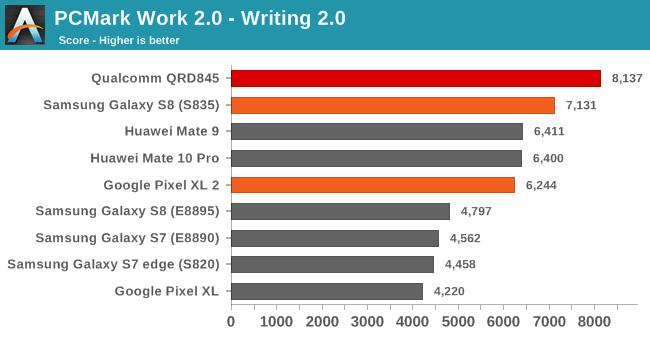
The Data Manipulation and Writing 2.0 tests make heavy use of the Android runtime and APIs and also a very memory latency sensitive. Between the best showings of the Snapdragon 835 variant of the S8 and the Pixel 2 XL in each respective benchmark, the Snapdragon QRD845 showed conservative increases of 8 to 14%. The Exynos SoCs lacklustre performance is again hampered by software and by bad memory performance.
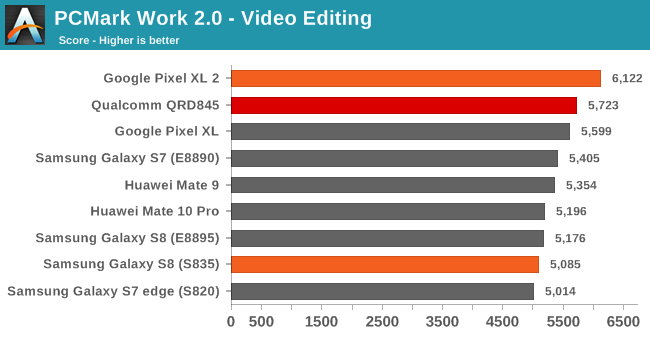
The video editing test is PCMark’s weak-point as it’s bottlenecked by things such as OS API overhead, and why we see tight grouping of performance results across a large range of SoCs. The Snapdragon 845 ends up high, but below the Pixel 2 XL. I would not put much weight on the results of this test as they’re not necessarily representative. Futuremark claims that the test is a lot more sensitive in mid- and low-range devices which can exhibit performance issues.
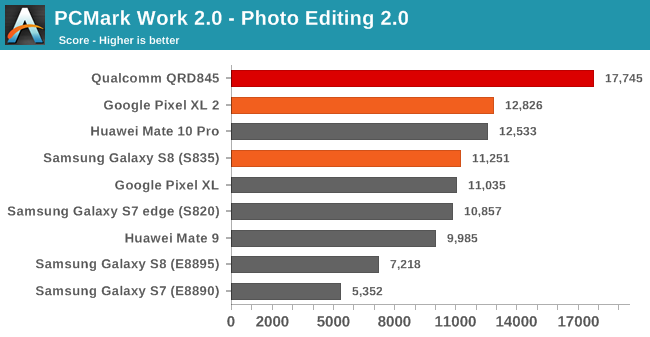
The photo editing test makes heavy use of Renderscript and use GPU acceleration to apply various effects on an image set. The QRD845 here shines as it’s able to showcase a 38% performance improvement over the Pixel 2 XL. Again the test not solely tests the raw performance of the system but also how optimized it is in terms of the software stack. This can be seen in the Kirin vs Exynos devices as Huawei’s phones vastly outperform Samsung’s devices in this test.
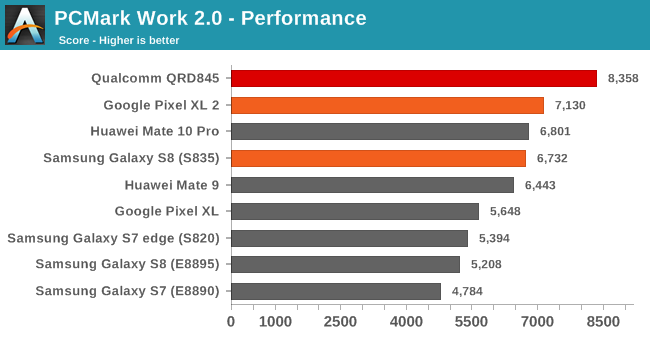
Overall PCMark’s performance score for the QRD845 increases by 17% over the Pixel 2 XL. Disregarding the video test, we see a similar scenario as in the synthetic tests as the new SoC’s CPU performance increases are lower than we had expected. Still the Snapdragon 845 is able to top the charts and should adequately power 2018’s flagship devices.
For 2018 we are reviewing our mobile benchmarking suite and altering some of the benchmarks we use. One of the changes in the way we benchmark devices is that we’re moving away from standalone browser and rather are benchmarking the OS’s WebView implementations. In general this seems to be a better choice for testing device experience as there is a lot of content that is being consumed via WebView windows. We also avoid the argument about different browser performance and since Google has now made WebView an updatable Play Store component we should also have valid comparisons older devices and systems. On the iOS side we do the same as we now benchmark browser tests within a WkWebView shell.
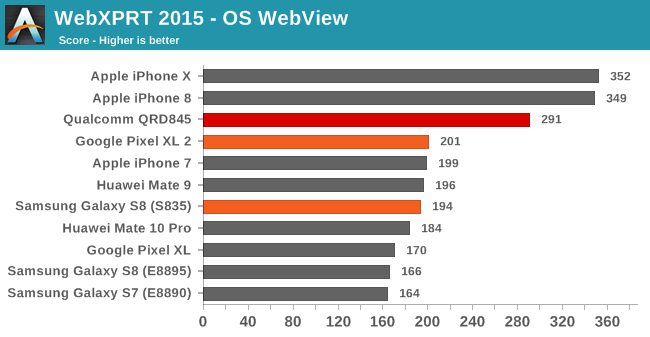
Starting off with WebXPRT 2015 for a last time before we’ll retire it in favour of WebXPRT 3, we see the QRD845 performing fantastically. Here the 44% performance increase over the Pixel 2 XL is a lot more in line with what we had expected of the new SoC. The QRD845 is even able to catch up a lot with Apple’s newest A11 and Monsoon cores in this test.
To keep up with the ever changing landscape of the developing web, we’re also retiring past JavaScript benchmarks in favour of a brand new and more representative benchmark developed by the WebKit team and welcomed by Google; Speedometer 2.0.

Here the Snapdragon 845 showcased another healthy performance increase of 37% over the Snapdragon 835 devices. Apple’s superior JavaScript performance can be attributed to a much faster and more optimized Nitro engine while Google’s V8 has only seen meagre improvements over the years. Notable is the Apple A11’s massive performance jump over the A10 – vastly increasing the distance to Android devices.










140 Comments
View All Comments
name99 - Monday, February 12, 2018 - link
"Waiting to see what happen in A12. It will likely just be a A11 in 7nm"Based on what? This ridiculous claim flies in the face of the five past generations of Apple CPU updates.
id4andrei - Monday, February 12, 2018 - link
Based on Apple's kneecapping of the previous three generations of Apple CPUs. They pushed too much on core performance, with complete disregard to the power constraints of the "thin" design (coupled with a flawed power delivery system). You've seen the result. Defective devices that cannot sustain their own performance across a single year.star-affinity - Wednesday, February 14, 2018 - link
”Defective devices that cannot sustain their own performance across a single year.”Not necessarily true! If the battery is healthy there's no down-throtteling. I think you have to be an extremely heavy user to wear out the battery in one year. My Iphone 6 has used about 620 cycles on its original battery and it's soon three years old. I use the phone every day and never turn it off. No down-throtteling for me according to Geekbench 4.
id4andrei - Wednesday, February 14, 2018 - link
Geekbench themselves found an instance of an iphone 7 being throttled. Battery life is supposed to take a hit as time goes and not the performance. This constitutes bad design, and indirectly, planned obsolescence.techconc - Wednesday, February 14, 2018 - link
The issue isn't to say that any of the phones can't be throttled if they have a bad battery. Batteries can go bad for simple things like being exposed to heat for prolonged periods of time. I'll back up star-affinity's claim by saying that I have a 6, 6s, 7 and X in use in my household. Even the oldest iPhone 6 that has been through heavy use on the original battery has not been throttled. According to Apple, it's a pretty rare condition where the throttling would actually occur.id4andrei - Thursday, February 15, 2018 - link
Your experience could very well be the one of the majority but this does not mean a larger issue did not exist, or otherwise Apple wouldn't have recalled a sample. After said recall, they still encountered the issue(through disgruntled owners) and decided to cover it up with a "fix". This is the crux of the matter, not bad batteries. Apple faced a total recall and they kneecapped all potentially faulty devices and thus removed themselves from complaints and warranty replacements. Most importantly they could get away with under-designing the battery for another two years.techconc - Friday, February 16, 2018 - link
Apple did not face a total recall. That is simply nonsense. I've seen random shutdowns on Android phones and on my older PC laptops. That's what happens when batteries degrade to a certain point. Unless there was a specific issue with a batch of batteries, there wouldn't be a recall.While I'd agree that Apple could have been more transparent with their updates, I also don't believe they were specifically trying to hide something. Go visit various Android support boards and you'll see plenty of battery related problems and devices randomly shutting down. This is not unique to Apple. What is unique here is that Apple provided a technical solution to mitigate these rare conditions for their customers. Their execution wasn't flawless, but they've done more than other vendors have.
StormyParis - Monday, February 12, 2018 - link
oups it be possible to have a bit more perspective. My issue is not "which flagship to buy", but whether it's worth it at all to buy this year's or last year's flagship (current answer: no, except for photographers).Extending the comparison to mid-range even low-end check would be helpful.
StormyParis - Monday, February 12, 2018 - link
"Chipsets" not "check"Alex_Haddock - Monday, February 12, 2018 - link
On a standard mobile device such as a smartphone the GPU improvements are pretty uninteresting to me but I assume for those into mobile vr applications it would be beneficial (but more so in dedicated devices?). This does look good with respect to Windows 10 on ARM though, hopefully an 845 based device won’t be too long after the launch 835 ones.